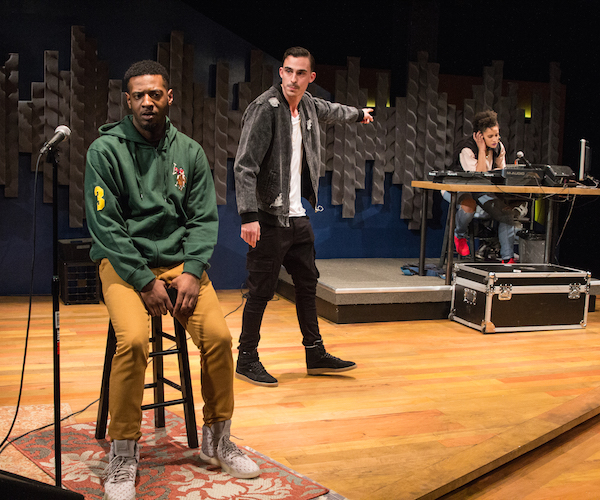Theater Review: “Hype Man” — Art Versus Politics
At a lean ninety minutes long, the play tackles too many big issues to do them justice.
Hype Man: a Break Beat Play by Idris Goodwin. Directed by Shawn LaCount. Staged by Company One at the Boston Center for the Arts Plaza Theatre, Boston MA, through February 24.

Khadah J Bennett, Michael Knowlton, and Rachel Cognata in the Company One production of “Hype Man.” Photo: Paul Fox
By Erik Nikander
The act of making art in collaboration with close friends can be a rich emotional experience. It can also be fraught with difficulty and frustration, especially when creative partners have wildly different ideas of what they want their art to accomplish. Some creative types favor art’s for art’s sake, but others feel a deep-seated need to use their talents and voices to change the world for the better. Idris Goodwin’s inventive Hype Man: A Break Beat Play explores this venerable divide with power, using hip-hop as a vehicle to examine racial discord and police brutality. The play’s conclusion feels underdeveloped, but Goodwin is adept at weaving his characters’ disparate needs and ambitions into a taut dramatic tapestry.
Hype man Verb (Kadahj Bennett) is at a rehearsal with hip-hop rising star Pinnacle (Michael Knowlton) and sound engineer Peep One (Rachel Cognata) when a lightning bolt of awful news arrives: a local black teenager named Jerrod was just shot to death by police. Verb and Peep are especially disturbed by the news, and want to address the injustice in their upcoming Tonight Show performance; Pinnacle nixes the idea. He is white. Peep and Verb are not. At the end of their live set, in front of the eyes of millions of people, Verb opens his jacket to reveal a t-shirt with three words emblazoned on it: “Justice for Jerrod.” Pinnacle is furious, accusing Verb of make him a target for racist backlash. The tension that ensues threatens to break the trio apart for good.
Hype Man dives into the stresses that often accompany political action. Verb and Pinnacle have been inseparable since childhood; now they are forced to weigh their friendship against the promise of material success and the fight for the greater good. The questions Goodwin has his characters confront are ones we all (including arts professionals) must face: What do we see in the society around us that is broken? Do we have a responsibility to use our strengths and talents to change the world for the better, even when doing so is difficult? Rap in particular has a rich history of fostering artists who agitate for social change. Goodwin makes effective use of the form’s theatricality: the hip-hop performances worked into the script imbue the play with dynamic jolts of energy.
Apart from the concert scenes, Hype Man takes place largely in the space of a recording studio, and director Shawn LaCount uses this location to provide the play with an aura of confinement. Sometimes the studio feels like a sanctuary; at other times it becomes reminiscent of the stifling, hot room in Twelve Angry Men. Verb, Peep, and Pinnacle are stuck together in one space, venting their needs, beliefs, and egos — each is trying to balance contradictory desires. LaCount beautifully realizes the dramatic possibilities of the space; he makes the stand-off intimate (rather than polemical), heightening tense standoffs and tender reconciliations alike.
Hype Man’s three performers do well by their dramatic responsibilities as well as the hip-hop performance scenes. Though their characters struggle to make art together without falling apart, the actors form a strong cohesive unit. None of the performers steal the show, instead, the emphasis is on collaborative strength. Rachel Cognata is terrific at highlighting Peep One’s uncertainty about her own identity, the inner conflict she feels over the direction of her career as well as her role as Pinnacle’s engineer. Pinnacle, as portrayed by Michael Knowlton, is lanky and stubborn. He deeply cares for his creative partners, which only heightens the sting of their “betrayal.” Kadahj Bennett’s Verb is thoughtful and fiery, a righteous warrior eager to take on the world’s injustice. In a few key moments, the actor also shows he’s got killer comic timing.
Lighting designer Jen Rock and sound designer Lee Schuna clearly had lots of fun crafting the performance scenes, turning the black box at the Boston Center for the Arts into a rap show venue. Thumping beats and dancing lights blend together, creating some mesmerizing entertainment. Though little of the actual scenery on-stage changes throughout the production, the audiovisual wizardry behind the concert performances completely transforms the studio space. Unfortunately, the noise generated by the sound mix washes out some of Goodwin’s lyrics, but the emotional message of each song comes through loud and clear.
Without giving too much away, a reconciliation occurs at the finale of Hype Man, in which Pinnacle comes to see the value of the struggle Verb and Peep are engaged in. It’s a joyful scene, but given the tangled, messy conflicts brought up by the play, the resolution comes off as slightly easy or unearned. The truth is that, at a lean ninety minutes, the play takes on too many big issues, but its to the credit of Goodwin’s writing that you leave wanting more. Company One’s world premiere production of Hype Man may fall short of complete success, but it asks compelling and pertinent questions about activism, race, friendship, and personal growth. Not enough of a good play is certainly better than too much of a bad one.
Erik Nikander is a critic, playwright, and filmmaker based in the New England area. His film criticism can be read on Medium and his video reviews on a variety of topics can be viewed on Youtube at EWN Reviews.
